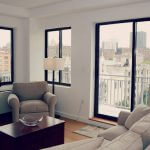By Mike Lentin
Ever wonder why your neighbor’s place is hushed and silent, when yours is alive with ambient sound—even though you live on the same street? The answer lies in the STC rating of your walls and Windows.
STC stands for Sound Transmission Class. An STC rating is a measurement of how much airborne sound a given building partition stops. When you talk about STC ratings, you’re talking about the doors, ceilings, walls, and Windows that muffle outdoor sounds.
Precisely measured, the STC rating scale allows for accurate, side-by-side comparisons of barriers. Using STC ratings, homeowners and professional builders can objectively assess Soundproofing quality and select the right barrier type for their needs. It all has to do with the attenuation of sound—how much intensity a sound loses as it passes through a barrier. For walls, the standard STC range is 33 – 46, and for single and double paned Windows, it’s 26 – 36. The higher the STC rating, the better a barrier is at blocking sound.
The History of STC Rating
Engineered in the 1970’s, the STC rating System is one of the oldest and most accepted ways of measuring sound attenuation through surfaces. It was originally developed to measure sound control between interior walls. Today, experts apply it to exterior walls, Windows, doors, and even ceilings. While the methods for measuring STC ratings have changed over the years, requesting a specific STC rating is still the most effective way to get the sound protection you need.
How is STC Rating Measured?
Generally speaking, STC ratings measure decibel deficits. If a 100-decibel police siren is only 75 decibels after traveling through your closed Window, then your Window has a 25-decibel deficit. The decibel deficit of a given barrier changes according to the tone or frequency of the sound passing through it: a higher- or lower-pitched tone may only experience a 5-decibel deficit.
Professionals calculate a barrier’s STC rating by measuring decibel deficits over a range of frequencies (from 25 to 4,000 Hertz), plotting them on a graph, and comparing the curve with standard STC reference curves. Whichever curve your graph most closely resembles corresponds with the barrier’s STC rating.
What Can An STC Rating Tell You?
If you’re not in the industry, choosing the right STC rating for your Windows, walls, or doors can feel a little theoretical. In general, you’ll be able to hear normal speech clearly through barriers with a rating below twenty-five. When you reach 35 STC, you can still hear loud speech, but you won’t be able to make it out. At 50 STC, you’ll only hear things like loud stereos or musical instruments. Depending on what you’re trying to block out, you may want to get a barrier with a specific STC rating.
Choosing Windows With the Right STC Rating
Given that the average STC rating for Windows is much lower than for walls, chances are new Windows will minimize the ambient noise in your home or office.
Installing thick, double pane Windows can reduce the noise of fire trucks, shouting, traffic noise, and subways. However, smaller noises become more noticeable as things quiet down, and so your noise problem may persist.
If you’re looking for a near-silent noise solution, you’ll need Soundproof Windows with an STC rating of 40 or higher. Double pane, laminated glass Windows injected with Argon or Krypton effectively block sound vibrations, mitigating the noise level in your home. In some cases, these Windows are more effective at blocking sound than your walls are!
Next time a jumbo jet passes over during dinner, your colleagues’ idle chatter distracts you from work, or a fire truck wakes up your little one, consider exploring Soundproof Window options with CitiQuiet. Our Soundproof Windows dramatically enhance the STC rating of homes and offices, providing peace of mind and sweet (almost) silence.



